
|
||
|
Portland art blog + news + exhibition reviews + galleries + contemporary northwest art
|
||
Richard Mosse: Exit Interview 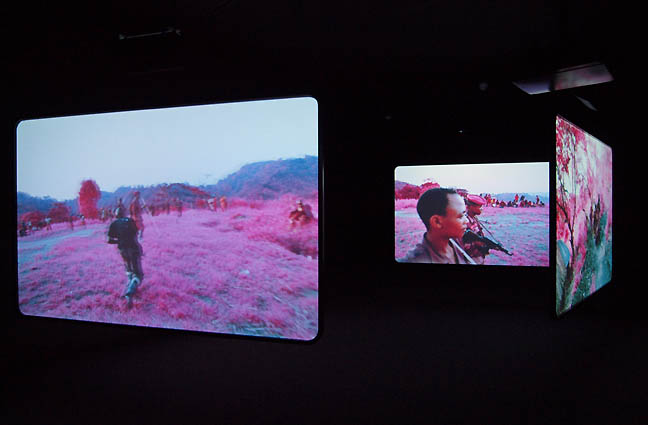 Installation view of Richard Mosse's The Enclave at the Portland Art Museum (photo Jeff Jahn) Richard Mosse's The Enclave at the Portland art Museum explores the uinimaginable experiences of disruption, diaspora and genocide in the constantly conflicted region of Eastern Congo. We sat down with him for an exit interview. Earlier we published a review, which captures many of the reasons it is among the most memorable exhibitions PAM has presented in the 16 years I've lived here. Jeff Jahn: Let's start with your background? Richard Mosse: Both of my parents are artists who do country pottery. I guess craftspeople. So they were very concerned that I would also be a starving artist. I was forbidden. 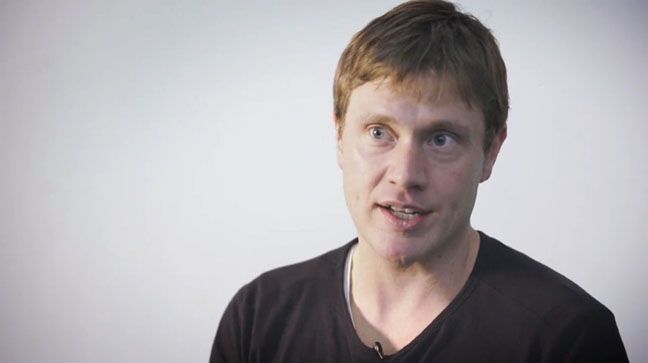
Richard Mosse J: So they pushed you towards a stable and lucrative degree in literature? R: (laughs) yeah yeah yeah, that's right you have obviously done your research, ex-hippies. J: So your parents were both potters, did they have studios near the house? Did you grow up in a studio environment? R: Actually they had an entire factory that used to be an old flour mill. Its on the River Nore in Kilkenny so they have hydropower with the kilns. Actually they are not ex hippies... they are still hippies so I guess photography was the furthest I could get from ceramics. J: Yes photography is a mechanical process, less earthy. But can you speak a little bit about your education in photography, most know you went to Yale which is known for churning out a certain kinds of photographer. You obviously have a relationship to documentary photography but it is also against the grain? Can you speak to that impulse to avoid and engage tradition, especially considering the pains you took to avoid ceramics. R: Well I suppose my work in Iraq was fairly straight forward documentary photography and more power to it I think it is a great project. I had a fellowship and I was trying to document Sadam Hussein's palaces. They were occupied by the US Military and it was pretty hard to get to these palaces but I realized my moment was fairly short before the US military sort of departed so I got myself inside and embedded and all that with an architectural camera and I got a series of images that were pretty good for what they are. But that stage I realized... when I was running out of grant money and becoming fed up with myself and how Id chosen a genre and a medium. Documentary photography is photojournalism in a way and that was sort of (laughs) roads to Damascus as the say. A crisis that I had and I was trying to find a new way from there. So that is where that initial Congo project emerged. I think you are right, Ive always been trying to work against the grain on same level but I think with the Iraq stuff it was more with the grain. But it is true there is a Yale aesthetic. Pictures of people's good looking friends with their T shirt off staring pensively at the horizon (laughs). That's Yale School, I'm being bitch now but that is ok. J: Ive found that most of the artists Ive worked with who have come through the art school school experience...Ive found the best ones always seem to interrogate that environment. They play Torquemada to the school. R: Before I got there, there was a guy named Matthew Montheith and he did a whole series on the Yale crits and all of his colleagues. They were great. J: Well it is certainly a place where things are expected to happen. People can begrudge something for being good at what they are and do but at the same time we look to institutions to uphold standards and Yale is a program by which things are measured. There are expectations and it gives you a sounding board. R: I think it is good, it is why we go to art school. It helps you find these points of resistance. Otherwise there isn't ant value in going? J: It is almost the obligation. That famous John Houseman line from The Paper Chase. “You come in here with a mind full of mush and we Mmmmould you.” isnt true but the animus it created is. Profs can be a guide but also a kind of way to sharpen yourself up. R: I think I came out with a head full of mush but I went in with ideas. J: Which prepared you for the Congo, or does anything really? Which brings us along this scenic route we are taking here to the body of work on display. You chose this rather exotic Aerochrome film, how did you come to that decision? R: That just sorta came to me. You know, I had read about it on the Internet. Like everyone I get all this spam in my email and most of it... my spam involves photography and all of these photography magazines like the British Journal of Photography, Photography District News... all of that stuff. Anyways they have all these bulletins. I try to ignore them but one of the bulletins was Kodak announces the discontinuation of Aerochrome film and by the end of the year, 2009, it would be finished. It was one of the first film stocks they killed off on their road to bankruptcy. So I thought this was fascinating on a number of levels because it touches on this threshold moment in the history of photography between analog and digital. Also, the film they were killing off was this very eccentric military technology , which I had never in my right mind thought of experimenting with because it is it has all these taboos... almost like a cliche that is so beyond cliche. There are certain things you just dont do as a self respecting photographer. One is cross processing and the other is using infrared film. You might have done it when you were 15 and experimenting but... J: Sorry to interrupt but you've summoned a ghost for me. The former curator of photography here at the Portland Art Museum Terry Toedtemeier, who died in 2008 while on the job did a series with infrared in the 70's. R: Oh cool J: You can see some of his work in the Blue Sky show, also on view here. He was the sweetest kind of rebel, if it was a no go that is where he went. You both have this similar intensity and contrarian curiosity. He was such a great guy and this is a place you would find him. R: I heard about him. He shot color or black and white? I think I saw a few black and white infrared? J: Black and white I believe. R: It isn't always that easy to recognize. You have such a strong photography community in Portland, it has been a revelation to me. J: yeah Bluesky last year had this great show of woven tapestry Chuck close pieces. R: Wow, so like what? Are they grids of 24 photographs woven together? J: No, literally it is a tapestry woven to translate the image into thread. The loom as the new darkroom! And they also displayed Robert Rauschenberg's final body of work there because his son Chris is one of Blue Sky's founders. It was very touching and Robert's also had that contrarian technical impulse, he's though of this assemblage artist but he's also a radical type of photographer with his x rays etc. So back onto you, you gravitated to Aerochrome. You didnt consider that for the Bosnia project? R: No, that was my first project as a budding artist in 2001 and it ran until 2004. At that time I was working in Kosovo but it was all related. This was at the time that I was struggling to get the hell out of academia but I ended up in a Master's in Cultural Studies but it was a very left field institution called London Consortium so they allowed me to integrate my pictures as part of my dissertation. J: Interesting, so before Yale you were doing cultural history... that's what I studied for my masters. So you really took the scenic route to art? R: Yeah they allowed me to use my own photos as a kind of skeleton to hang these ideas off. It was a bit like a prosaic version of W.G. Sebald. He was a big influence to me. So I got to put my silly little pictures in and then spin my arms around them with Judith Butler or Walter Benjamin or Adorno or Thomas Struth. Looking at other people's pictures as well. It was really about memory and loss how it was written in Kosovo's landscape. Early on in that project I was working on this abstraction again of trying to document the story and capture this story about missing person's crisis around the former Balkan nations where there were a lot of people still missing. Their bodies are probably in mass graves but they havent been recovered. Where they had located the mass graves they could not identify them so easily because the bones are rotton. So there is this sort of gap or absence in the population and no one can work out if they are dead or alive. This is a really big problem to document because you are trying to point your camera at something that wasn't there. So that was really the start of the whole theme for me. And that relates directly to the Congo work which really about the absence of a trace. That is the thing that pulled me away from photojournalism with its pictorials and its reductiveness, driving me towards contemporary art and its ability to make visible what can't be seen in a way that is beyond language. J: There is this tension between the historical community and journalists. It exists partially because historians are always unpacking and reassembling the past, interrogating the narrative. This is true of even the recent past with new information that didn't fit journalism’s neat rush for comprehension. Sometimes the answers just arent that tidy and that is still a valuable story. Perhaps that is why journalism and contemporary art also have a tense interchange that music, dance and fine food dont have? Historians and contemporary artists are more interested in what gets left out and try to bring the richer more complicated details back into present discussion. Every time someone mistakenly labels me a journalist I correct them... Im a Historian working in the present, I have no deadline sand will publish something when I feel it is ready. It is for my own curiosity and something like the tradition of what Herodotus and Charles Baudelaire did. I noticed in interviews you avoid calling yourself a photojournalist and describe yourself as a documentary photographer. R: Yeah, I dont think it is fair to journalists if I call myself a journalist. Most of them at least live according to a certain, strict code and they have to verify facts at least twice and it is a completely different way of working. Although I am going in the same destinations and am documenting history I have total freedom because I'm working for myself , I'm networking for a deadline or a series of editors. And my work is not going to be chopped and changed in the same ways. I have different freedom and I'm only responsible to myself. It sounds a bit pragmatic and maybe it is but I'm not there to claim some impartial veracity it is from point of reference. That is all I can relate, whereas a journalist is to piece together this objective reality. J: and there is a kind of linearity that come from that too. R: a distortion J: ...that is trying to make sense of something, I think artists, their critics and art historians want to explore the mechanisms of why certain things are hard to understand. Artists even get to use those mechanisms. The resistance to comprehension doesn't mean it cant be explored through its complicated dissonance. Which leads us to the complicated dissonance of your Congo project, how did that come about? 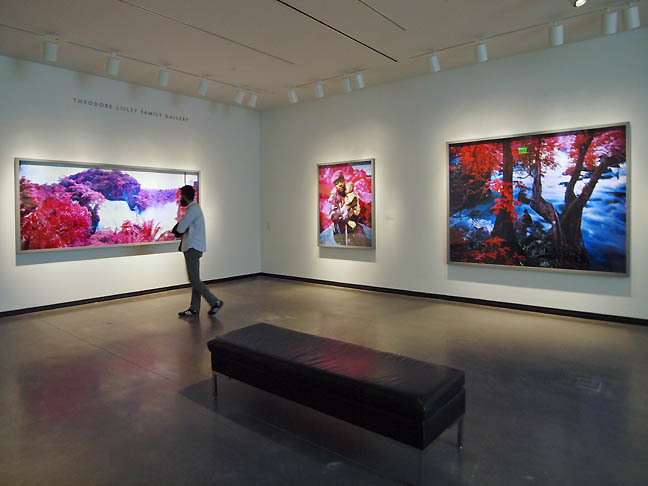 Gallery view of The Enclave at the Portland Art Museum R: Well it was really that Aerochrome film that came along first and then I was, where will I take this? I was very interested in the fact that it reveals an invisible spectrum of light. It reveals the unseen. Then it was like what story relates metaphorically to that aspect? So I did some research and realized that the situation in the Eastern Congo has something essentially overlooked, hidden and unseen about it. Because there was this huge huge statistic of like 5.4 million people dead of war related causes since 1993. Yes, does that get on the front cover of the news? Do you see it on the nightly news... no you dont. So it has this problem of being communicated was interesting to me. Even in my wormy mind I could see how I could use this film to reveal the unseen, the hidden and take it to this place that was in a way invisible. It was like colliding thees two completely incongruous things and making this single metaphor. J: Why does the military get all of the intelligence tools? At least with cell phones it is starting to effect the police but the Congo needed something more. Besides, except for George Clooney renting satellites the surveillance for fact finding generally isnt in the hands of anything but governments. R: Yeah it is really changing with sommany video capable cell phones. J: So you went to the Congo with the idea of doing the film first? R: No no, I started off very slowly with it with one camera living in catholic missions where it is cheaper than the hotels. So I built up an understanding slowly over a couple of years that way. Then at a certain point it got momentum and a Guggenheim fellowship. That helped me finish that first body of work in Congo which became a book with Aperture Foundation which was co-published by Pulitzer's Center on crisis reporting. So I did that and did the show and most sane people would stop there (nervous laughs) but I realized there was more to it and I really wanted to keep pushing and make it into a film installation. 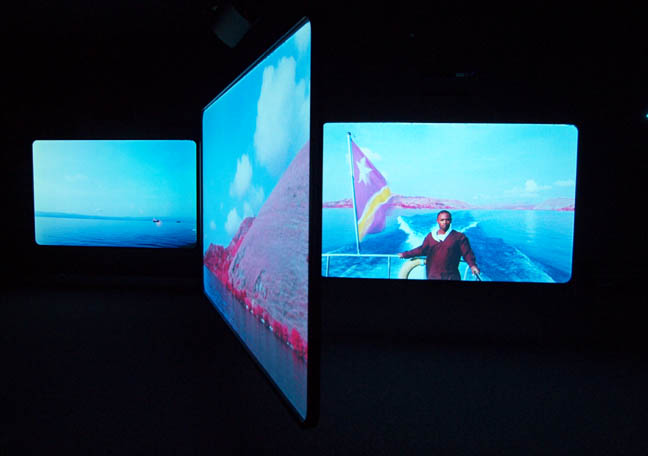 The problem was I couldnt find that film in the moving picture form. Then I had the good luck to find a big stash of it. 33 reels of it. It was a special order and naturally... nobody ordered it because it is kind of an unstable film to use but there was some daft indie film that was supposed to be made 10-15 years ago that was meant to be set in Death Valley and the director insisted,as they do that It's got to be shot in infrared man. So they bought all this infrared film. It was a special order and Kodak produced it specially for the film, one of the rare times they made this motion picture film. Then the director of photography did his research, as they do and realized it is a nightmare because it is critically unstable. It only lasts 7 days at room temperature. So to take it to Death Valley, which is very hot is really pushing it past the threshold of sense. So he saw sense and said we cant do this. So they put the film into a freezer … I dont know where. Then I heard it existed and kept hearing it existed. Then I made this approach through networks of used film dealers. It is always shady and then finally every time it came back,”oh no it doesnt really exist.” I kept pushing. I did that for two or three years actually and then finally I tried one last time and the next day I heard that this guy whoever owns it , his wife just had a baby and so his life priorities changed and so he realized he should really sell all this crap in his freezer after all. So I made him an offer and by the next day I had all of the film. That was great and the start of the project . Before that Trevor Tweeten and I, who Ive been working with ever since 2008 went along to shoot this unambitious little film. Eventually we began to understand what really needed to happen and I developed a real awareness of how too work together, which is really special . It took a long time to evolve that and when we got the film were really ready to do something very ambitious. So we really hit it hard. 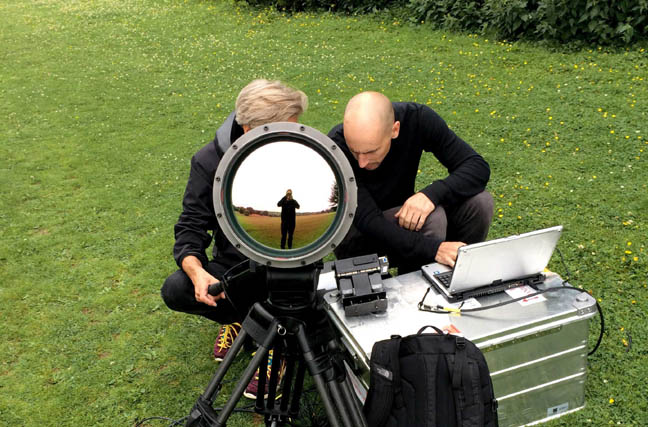 Mosse (reflected) and team Then this musician Ben Frost, dropped me a line on the email and said hey dude I saw your new book. I really like it, respect it. So I googled him and it turns out he is a staggering genius. A minimal composer based in Iceland and Australia and he’s turning into a rockstar now. He's going all the way. So I wrote back to him. We've never met but do you want to go to Congo next week? (half-crazed incredulous laughter) J: Oh man! R: So he's like yeah mate. So that was really the start of it. J: What could go wrong? R: So there was always a lot of risk involved in The Enclave. Huge uncertainty and because it was documentary there was no script. You can really script the world you have to let it reveal itself. It was a really dangerous place because of this insidious level of corruption where nothing could be predicted. That which should take a day takes a week and it is just a nightmare. But if you make a plan and that plan goes completely out the window and you are open to chaos then you are ready for the Congo. We were able to do that somehow. J: That is pretty amazing. So the choice to go nonlinear with this cubist multipaned presentation. R: So we wanted to formally echo our experience of working in the Congo. There the infrastructure is such that there arent that many paved roads in the East and a lot of the conflict happens deep in the bush so you can really verify the fire. Even if you hear about it it can take3-4 days before for any sort of evidence to emerge. It is hard to get into the bush to prove anything. So there is a lot of rumor and fear. It's hard to have one since narrative, in fact it is such a fragmented conflict with at least 30 different armed groups. There are many different fronts and alliances... changing alliances so what we were trying to do is create this kaleidoscopic, immersive disorienting environment to push the viewer to take a number of different viewpoints. To force the viewer spatially to participate in the environment so they can piece together things themselves rather than being dictated to like a documentary. A documentary tells you what to think and then you leave and think, that's awful we must stop the Tutsi. Whereas this piece disorients you and confuses you until you can start to construct your own sense of the situation. J: You have your landscape shots and a lot of roads and rivers which traverse . I recall a great number of shots of people walking and you seem to be walking along with them. The viewer is put within the kinesthetic frame of reference. You feel like you are traversing space. But there is one segment I have to ask you about, the part where they are moving the building. What is happening there? R: That is something people do in Goma and Congo. When you move house you actually physically do move the house. Ive seen it a few times and I though geez that is the weirdest looking metaphor for the displacement of the population. So it speaks to me of fleeing violence. That was in the early stage of making The Enclave and the conflict wasn’t so close to us so we couldnt palpably experience the proximity to the fighting. So we were dealing with the abstractions in a way that. It was metaphor and we were treating it like a poet would. Present participle words like fleeing, easing, meeting, dieing and beating. What you are seeing has all of those elements I just named. Dieing, being born, massacre... all of these people being massacred are being buried. Then on another screen there is a child being born. J: It looks like there is a coffin in another screen when the house is moving. R: in a way the house functions like a coffin as well. It is one of the most disjunctive scenes in the whole piece and it follows on the heels of one of the most harmonious scenes of a refugee camp of IDP's Internally Displaced people. J: Somebody though I might be you when I was waiting to meet you and they asked me if some of the bodies are staged? They didnt see flies on some of them. R: There are a number of different battles which are sequenced in the piece. One of which is simulated by the rebels. J: Yeah it looked like a game of tag almost? 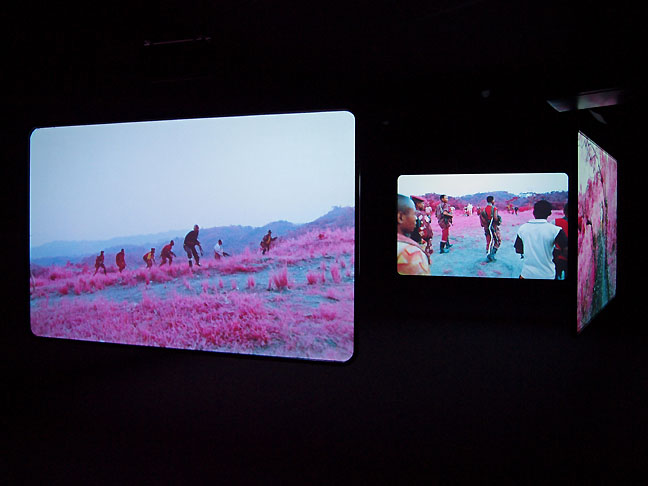 Pantomime moment in The Enclave (photo Jeff Jahn) R: and they were laughing,almost like a pantomime. They really enjoyed that. We showed up at this quite remote rebel enclave, Fizi. And they are like, “Why the hell are you here?” So I just explained that Im here to document the troops and tell your story to the world.So I just explained that Im here to document the troops and tell your story to the world. So the next day, after discussing overnight what they would do, and they decided to put on these maneuvers. It is a simulated battle which turned into more of a game than anything. Strange and very sinister of course as well but with all the funny noises they made it was almost like children playing cowboys and indians in a way except they have real heavy weapons. And actual children are actually running in and amongst them as well so it is very weird. So that's one, sequence where there are people pretending to be dead then there is a battle which you can hear only. At Goma where the National Army is and the UN are pushing back we got caught right in the middle of that. We recorded that with the binaural zoom mic and that was put together by Ben in the space so that is another sequence. You'll notice when it goes completely black and you hear artillery noises. J: Other moments I heard walkie talkies etc. R: yeah yeah yeah so that actually went on for 14 hours but we we left it at just one minute. At the enduring the battle for the city of Goma it is the silent sequence which most people miss because it doesnt have this drama to it. J: It is beautiful, so many documentary films add a Hollywood soundtrack which cues you how to feel and I Love that it went silent. 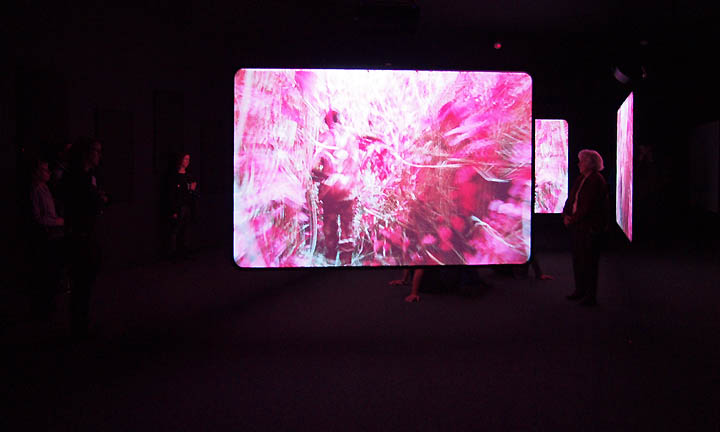
R: so glad that you liked that. Because a lot of people completely miss it but our point was to deflate the spectacle. The scene preceding that is very much like Apocalypse Now with these guys beside a river gesturing towards the foliage but there is nothing there. And they are pretending to shoot it so there is this heightened sense of suspense. The audio also heightens the suspense because there are these insect noises and deep bass so you are kind of expecting something to happen. And nothing happens and then we go to the silence. We suck the sound out from the bass up. You can hear it over the course of about 6 seconds. Then it goes through the mid tones and the the high end is the last thing you hear. Then we desaturated the the final frames of the film so it is not quite as vivid. And all of the scene were shot in such different ways stylistically because we were running litterally for our lives through the city of Goma. The streets had active live fire and you cant really shoot with a streadycam. In those situations unless you are completely insane. So we had a slightly longer lens on. So what is produced is a lot more cinema verite look. Its more evocative of classic reportage photography too. J: It is more tunneled, like the way your vision narrows under the stress of G forces. There is this expansiveness before that moment with vast landscapes and then it condenses space and collapses upon you. R: Exactly, and that has to do with the lens and we have on, going back to hand held and we are running. Because it is silent it relates in my mind to newsreel photography, the stuff that came out of WWII. As a whole the project and not just the film it is really changing gears and challenging the conventions of war photography. It pushes at the limits to find the limits at least, which is kinda taboo because war photography is a conservative medium aesthetically for a very good reason because you are aestheticizing human suffering. War photographers often pretend they are not doing that by de-aestheticizing through using grainier film or black and white or by taking ugly photos. All of which are also aesthetic decisions. They aren't avoiding the problem they are pretending they are avoiding it. So we were trying to turn it the other way. Posted by Jeff Jahn on April 12, 2015 at 12:25 | Comments (0) Comments Post a comment Thanks for signing in, . Now you can comment. (sign out)
(If you haven't left a comment here before, you may need to be approved by
the site owner before your comment will appear. Until then, it won't appear
on the entry. Thanks for waiting.)
|
| s p o n s o r s |
 |
 |
 |
 |
 |
 |
 |
 |
 |
 |
 |
 |
 |
 |
 |
 |

|
Site Design: Jennifer Armbrust | • | Site Development: Philippe Blanc & Katherine Bovee | |

